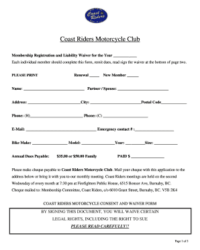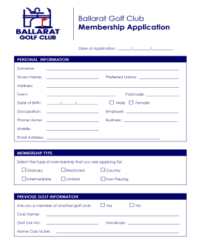Utilizing a pre-designed structure streamlines the application process for both applicants and administrators. It reduces the likelihood of incomplete submissions and ensures all essential information is gathered. This efficiency saves time and resources, allowing administrators to focus on evaluating candidates rather than chasing missing data. Furthermore, a well-designed form can enhance the professional image of the organization and create a positive first impression for potential members.
The following sections will delve deeper into the key components of effective forms, best practices for their design and implementation, and the various formats available for modern organizations.
Key Components of a Membership Application Form
Effective application forms gather essential information while presenting a professional image of the organization. The following components are crucial for achieving these objectives.
1. Contact Information: This section collects the applicant’s full name, phone number, email address, and physical address. Accurate contact information is essential for communication and record-keeping.
2. Personal Background: This may include date of birth, occupation, and other relevant demographic information. This data assists the organization in understanding its membership demographics and tailoring activities accordingly.
3. Interests and Hobbies: Inquiring about interests and hobbies helps the organization connect members with shared interests and facilitates the formation of special interest groups.
4. Reasons for Joining: Understanding an applicant’s motivations for joining provides valuable insights into their expectations and allows the organization to assess alignment with its mission and values.
5. Referral Information (Optional): If applicable, including a space for referral information can help track membership growth and recognize existing members who contribute to recruitment efforts.
6. Membership Type Selection: If the organization offers different membership tiers, the form should clearly outline the options and associated benefits, allowing applicants to make informed choices.
7. Signature and Date: Including a space for signature and date formalizes the application and signifies the applicant’s agreement to the organization’s terms and conditions.
8. Data Privacy Consent: In compliance with data protection regulations, obtaining explicit consent for data collection and usage is paramount. This section should outline how the organization intends to use and protect the applicant’s personal information.
A well-designed form facilitates a smooth and efficient application process, ensuring the organization collects all necessary data while providing a positive experience for prospective members. Careful consideration of these components contributes to the overall effectiveness of the application process and strengthens the organization’s administrative procedures.
How to Create a Membership Application Form
Creating a well-structured application form is essential for efficiently managing new member onboarding. The following steps outline a practical approach to developing a comprehensive and user-friendly form.
1: Define Objectives: Clearly outline the information required from applicants. This ensures the form collects all necessary data for effective evaluation and administration.
2: Choose a Format: Select a format paper, online, or a combination that aligns with the organization’s resources and target audience. Online forms offer advantages in terms of automation and data management.
3: Structure the Form: Organize the form logically, grouping related fields together for clarity and ease of completion. Clear headings and concise instructions enhance usability.
4: Craft Clear Questions: Use precise and unambiguous language to minimize confusion and ensure accurate responses. Avoid jargon or technical terms that might not be familiar to all applicants.
5: Include Essential Fields: Incorporate fields for contact information, personal background, interests, reasons for joining, membership type selection, and data privacy consent. Consider optional fields for referrals.
6: Design for Accessibility: Ensure the form is accessible to individuals with disabilities. This includes considerations for font size, color contrast, and screen reader compatibility.
7: Test and Refine: Before finalizing the form, conduct thorough testing to identify any usability issues or areas for improvement. Gather feedback from potential users to optimize the form’s effectiveness.
8: Implement and Maintain: Once finalized, implement the form and establish procedures for processing applications. Regularly review and update the form to ensure it remains relevant and effective.
A well-designed form simplifies the application process, enhances the organization’s image, and contributes to efficient membership management. Following these steps helps ensure a streamlined and effective approach to welcoming new members.
Standardized forms provide a crucial framework for managing new member intake within social clubs. From ensuring consistent data collection to streamlining administrative processes, a well-designed structure offers significant benefits for both the organization and prospective members. Key components such as contact details, personal background, interests, and reasons for joining enable the club to understand its membership base and tailor activities accordingly. Careful attention to design, accessibility, and data privacy further enhances the application process, creating a positive first impression and fostering a sense of professionalism.
Ultimately, an effective structure contributes to the long-term health and vitality of a social club. By simplifying administrative tasks and facilitating meaningful connections between members, it strengthens the organization’s ability to foster a thriving community. Implementing a well-considered approach to membership applications is an investment in the future success and sustainability of the club.


